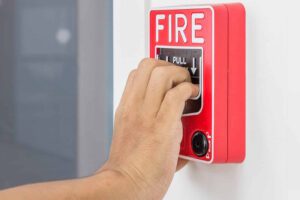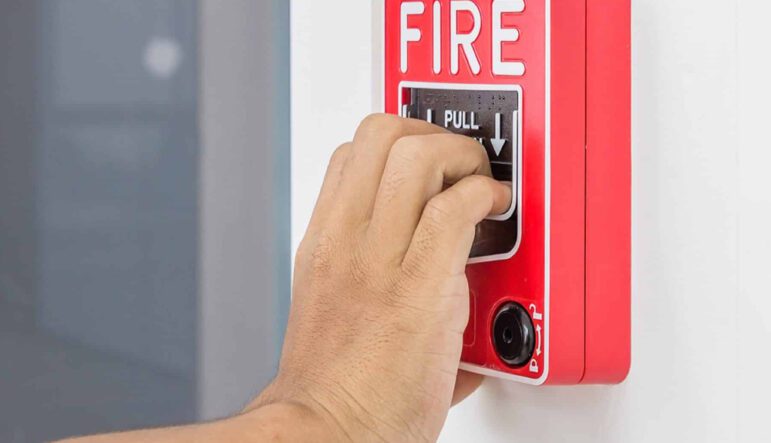Ultimate Guide to Fire Alarm Systems in South Florida…
 Fire alarm systems are crucial in safeguarding lives and property from the dangers of fire. These systems are designed to detect smoke, heat, or flames and promptly alert occupants, allowing for safe evacuation and notifying emergency services. With the increasing complexity and variety of fire alarm systems available today, understanding their components, types, and functionalities is essential for effective fire safety management. This guide will provide an in-depth overview of fire alarm systems to help you make informed decisions regarding their installation and maintenance.
Fire alarm systems are crucial in safeguarding lives and property from the dangers of fire. These systems are designed to detect smoke, heat, or flames and promptly alert occupants, allowing for safe evacuation and notifying emergency services. With the increasing complexity and variety of fire alarm systems available today, understanding their components, types, and functionalities is essential for effective fire safety management. This guide will provide an in-depth overview of fire alarm systems to help you make informed decisions regarding their installation and maintenance.
Understanding Fire Alarm Systems
Fire alarm systems consist of interconnected devices that work collectively to detect and alert occupants of a potential fire hazard. The primary function of these systems is to provide early detection, ensuring that individuals have sufficient time to evacuate safely. A typical fire alarm system includes several components, such as initiating devices, notification appliances, and control panels.
Key Components of Fire Alarm Systems
-
- Fire Alarm Control Panel (FACP): The brain of the fire alarm system, the FACP processes signals from various devices and coordinates the system’s response.
- Initiating Devices: These include smoke detectors, heat detectors, and manual pull stations that trigger the alarm when they sense a fire hazard.
- Notification Appliances: These devices, such as horns, strobes, and speakers, alert occupants to evacuate the premises.
- Power Supply Units: These ensure that the system remains operational during a power outage, providing both primary and backup power.
- Emergency Control Function Interfaces (ECFI): These interfaces connect the fire alarm system to other critical building systems, such as HVAC systems and fire doors, enhancing overall safety.
- Annunciators: Visual displays that provide information about the system’s status and any active alarms, allowing for quick assessment and action.
- Emergency Voice Alarm Communication Systems (EVACS): These advanced systems provide verbal instructions during emergencies, guiding occupants to safety.
Types of Fire Alarm Systems
Fire alarm systems can be categorized into various types based on their design and functionality. Understanding these types is vital for selecting the most appropriate system for your building.
1. Conventional Fire Alarm Systems
Conventional fire alarm systems utilize analog technology and divide a building into zones. Each zone contains multiple detectors connected to the control panel. When a detector in a zone is triggered, the panel indicates the general area of the alarm but does not specify the exact location.
Advantages:
-
- Cost-effective for smaller buildings.
- Simple installation and maintenance.
- Reliable for basic fire detection needs.
Disadvantages:
-
- Limited information regarding the specific location of the fire.
- More wiring required compared to other systems, increasing installation complexity.
2. Addressable Fire Alarm Systems
Addressable fire alarm systems employ digital technology, assigning unique addresses to each device. This allows the control panel to identify the exact location of a triggered alarm, enhancing response times.
Advantages:
-
- Precise location tracking reduces emergency response times.
- Easier troubleshooting and maintenance due to detailed diagnostics.
- Scalable and customizable to meet specific needs.
Disadvantages:
-
- Higher initial costs compared to conventional systems.
- Requires specialized knowledge for installation and maintenance.
3. Wireless Fire Alarm Systems
Wireless fire alarm systems use radio frequency technology to communicate between detectors and the control panel, eliminating the need for extensive wiring.
Advantages:
-
- Flexible installation options and quick setup.
- Easy to expand by adding more devices.
- Cost-effective due to reduced labor and material costs.
Disadvantages:
-
- Signal interference can occur due to building materials or other wireless devices.
- Battery dependency necessitates regular maintenance and replacements.
4. Hybrid Fire Alarm Systems
Hybrid fire alarm systems combine features of both conventional and addressable systems. They can utilize both wired and wireless components, offering flexibility for various building layouts.
Advantages:
-
- Customizable to fit specific needs and building configurations.
- Scalable for future expansions.
- Cost-effective by utilizing existing wiring while adding new components.
Disadvantages:
-
- Complex setup requiring careful planning.
- Higher initial costs due to the combination of technologies.
Factors to Consider When Choosing a Fire Alarm System
Selecting the right fire alarm system involves careful consideration of various factors that affect its performance and suitability for your building.
1. Building Size and Layout
The size and design of your building play a significant role in determining the appropriate fire alarm system. Key considerations include:
-
- The number of floors and total square footage.
- The occupancy type and density.
- The presence of any unique architectural features that may affect detection.
2. Type of Business
Different businesses have distinct fire safety needs based on their operations and potential hazards. For instance:
-
- Restaurants may require specialized systems for kitchen fires.
- Warehouses may need enhanced smoke detection capabilities.
- Healthcare facilities often necessitate more advanced systems due to the vulnerability of occupants.
3. Compliance with Local Codes
Understanding and adhering to local building and fire codes is essential. These regulations dictate the minimum requirements for fire alarm systems, including:
-
- The types of detectors and notification devices required.
- The placement of manual pull stations.
- Integration with other safety systems, such as sprinklers.
4. Budget Considerations
Budgeting for a fire alarm system involves evaluating both initial installation costs and ongoing maintenance expenses. Considerations include:
-
- The type of system selected and its features.
- The number of components necessary for adequate coverage.
- Potential savings on insurance premiums due to enhanced safety measures.
Installation and Maintenance of Fire Alarm Systems
Ensuring the effective operation of fire alarm systems requires regular installation and maintenance practices. Proper installation by certified professionals is crucial for optimal functionality.
Installation Process
-
- Site Assessment: Conduct a thorough evaluation of the building to determine the best locations for detectors and notification devices.
- System Design: Develop a comprehensive plan that outlines the configuration of the fire alarm system, including wiring and device placement.
- Installation: Follow industry standards and manufacturer guidelines to install the system, ensuring all components are properly connected and functional.
- Testing: Conduct rigorous testing of the system to verify that all devices are operational and that communication between components is seamless.
Regular Maintenance
Regular maintenance is essential for ensuring the longevity and reliability of fire alarm systems. Key maintenance practices include:
-
- Visual Inspections: Conduct routine checks to ensure all components are in good condition and free from damage.
- Functional Testing: Perform regular tests to verify that the system responds correctly to alarms and that communication between devices is intact.
- Battery Checks: Inspect and replace batteries as needed, especially in wireless systems that rely on battery power.
- Documentation: Maintain detailed records of inspections, tests, and maintenance activities to ensure compliance with local regulations.
Integration with Other Safety Systems
Integrating fire alarm systems with other safety technologies can enhance overall building safety and streamline emergency response efforts. Common integrations include:
1. Sprinkler Systems
Integrating fire alarms with sprinkler systems allows for automatic activation of sprinklers when a fire is detected, providing immediate suppression of flames.
2. HVAC Systems
Linking fire alarms with HVAC systems can prevent the spread of smoke by shutting down air handling units, helping to contain the fire within a specific area.
3. Access Control
Integrating fire alarms with access control systems can facilitate automatic unlocking of doors during an emergency, allowing for safe evacuation.
4. Mass Notification Systems
Combining fire alarms with mass notification systems enables real-time communication with occupants during emergencies, providing clear instructions for evacuation.
The Importance of Fire Alarm Monitoring
Fire alarm monitoring involves connecting your system to a central monitoring station that can dispatch emergency services when an alarm is triggered. The benefits of having a monitored fire alarm system include:
1. Rapid Response
Monitored systems ensure that emergency services are alerted immediately, reducing response times and potentially saving lives and property.
2. 24/7 Surveillance
With round-the-clock monitoring, your system is continuously observed, ensuring that any alarms are addressed promptly, even when the building is unoccupied.
3. Peace of Mind
Knowing that your fire alarm system is monitored provides reassurance to occupants and building owners, enhancing overall safety and security.
Cost Considerations for Fire Alarm Systems
Understanding the costs associated with fire alarm systems is crucial for effective budgeting. Factors influencing costs include:
1. System Type
The type of fire alarm system selected significantly impacts the overall cost. Addressable systems tend to be more expensive than conventional systems due to their advanced features.
2. Installation Complexity
The complexity of the installation process, including wiring and integration with other systems, can influence labor costs.
3. Maintenance and Monitoring
Ongoing maintenance and monitoring services contribute to long-term costs. Regular inspections and tests are necessary to ensure compliance and functionality.
4. Potential Savings
Investing in a reliable fire alarm system can lead to savings on insurance premiums and reduced property damage in case of a fire, making it a worthwhile investment.
We Provide Fire Alarm Installation and Repair Services
A well designed and installed fire alarm is the basic element of a fire protection system. The dependable fire alarm system installed in your premise makes certain absolute code compliance and safeguard lives.
> Learn More
Contact Us (905-870-7779) for a Free Consultation!
—

About TAS Fire Protection
TAS Fire Protection offers comprehensive and cutting-edge fire protection and security services to commercial, industrial, and high-rise properties. Our team of highly skilled professionals has years of experience in installing, maintaining, and inspecting fire alarm systems, fire sprinkler systems, fire extinguishers, fire hydrants, security alarm systems, and more. We understand that fire safety and security is essential to the protection of lives and property.
> Learn More

